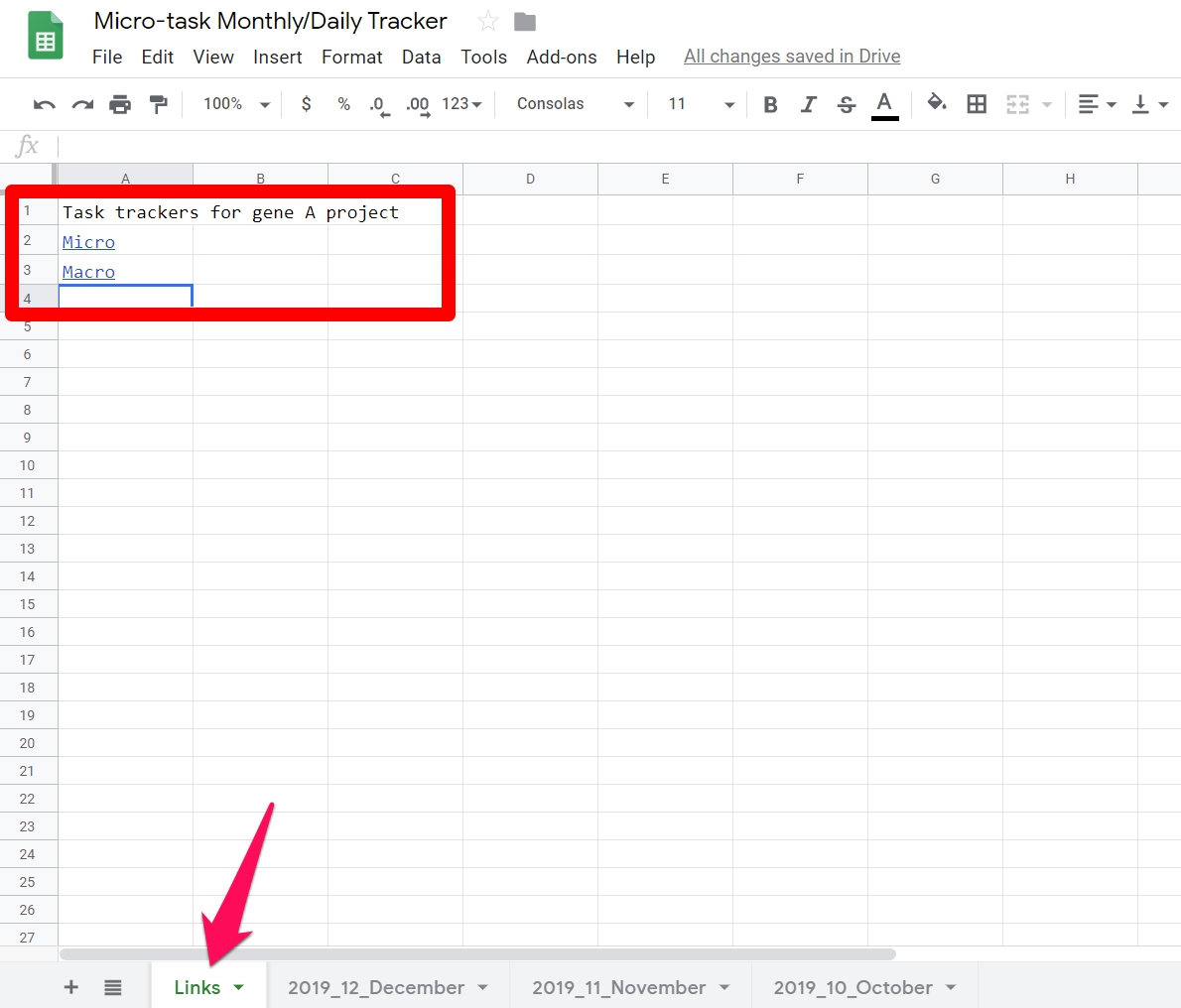2019-12-02 RESOURCES
Author: Cait Kirby
Read time: 6 minutes
So you want to stay organized, huh?
Build a better to-do list.

During the first two years of my PhD, I was so focused on the day-to-day tasks that I missed the overall goal of the project. Then, when I finally took the time to focus on the big picture, I missed a crucial time point for my experiment. I was constantly struggling to accomplish the right things and my to-do list never got shorter. Over the last two years, I have honed a project management system that works at two levels: both the micro and macro. However, you can choose to use only one, if that suits your project better. Importantly, these tools are infinitely customizable and adaptable for your needs. Please let me know if you find these tools useful, or if you have creative ways of adapting them for your needs!
Micro-level organization spreadsheet
In my experience, writing down the task increases the likelihood that I will accomplish that task by orders of magnitude. As such, I have constructed a monthly spreadsheet, broken down by week and day, like a calendar. For each day, I have three columns: a checkbox, a task name, and a column for notes. I write down all the tasks I must accomplish that day. I often add a few "extra" tasks that are not absolutely required for that day. These "extra" tasks are mobile, and may be moved to another day or week, given constrains and variables. For individuals with volatile health states or children with variable schedules, some days have more unknowns, and thus more tasks may be considered "extra." In the notes column of my checklist, I denote these tasks as "extra" or "not necessary" with a symbol. By identifying which tasks are required and which are extra beforehand, an individual who becomes unwell can immediately look to the to-do list to know which tasks are inessential. If an individual is overcome wtih fatigue, the individual can focus only on the essential tasks. In contrast, if an individual is having a particularly energetic day, they can strive to accomplish all tasks.
I like to print out my to-do list at the beginning of the day, and check off tasks on the analog copy as I go.
The act of checking off each tasks gives me a feeling of accomplishment and motivates me to accomplish more.
Later that day or the following morning I return to my digital copy and record my accomplished tasks with a checkmark.
This promotes accountability, since I hate when a checkbox goes unchecked.
Then, I begin again, with the checklist for the next day.
Some days I actually prepare my checklist ahead of time.
This works well if that day will be particularly busy, or if I feel a flare coming on.
This way, I can plan my list when I'm feeling calm and healthy, and when my mind is very clear.
Then, when I am feeling less well, all I need to do is follow my own instructions.
Click here for my example micro-level task-tracking spreadsheet & walk-through.
But, micro-level planning is not enough!
This micro-level list is great for focusing on the granular details of experiments.
However, the overall goals of the project are easily lost by focusing only on such minor details.
In other words, you can miss the forest for the trees.
Thus, I also use a big-picture tracking tool: another spreadsheet.
You can link these two spreadsheets using this "Links" tab on both spreadsheets, shown with a pink arrow.

Macro-level organization spreadsheet
Attention to granular detail is necessary for experimental success. However, a focus on the big-picture goals of the project is crucial to remain on track and timely. Thus, I utilize a birds'-eye-view spreadsheet that helps me maintain focus on the larger goals, from figures to papers to career-goals. The specific structure for these spreadsheets varies based on the goal, but the overall idea remains the same: what are the high-level chunks of this project and how can I break them down? For a paper, I plan out each figure, and break down each panel of the figure. I further break it down to include experiments that are required to achieve the figure, but will not be included in the figure itself. For example, there may be many troubleshooting Western blots to optimize the sample and antibody concentrations before the final Western is publication-ready. It is crucial to include these experiments in my planning, as they take significant time and focus. Importantly, these high-level check-boxes do not get checked off until all the lower-level check-boxes are checked off. This is a great motivating factor, and helps me to finish off the small tasks that prevent a task from ever really being finished. Anyone who has carried out these experiments knows how many small experiments will go into these two small figures. For example, fig 1A Sanger sequencing requires:
Any one of these steps can fail and require optimization. Thus, it is crucial to account for each of these steps in our checklists. Accounting for each of these steps can help to estimate the length of time it will take to complete each figure. Most importantly, it can be so overwhelming trying to troubleshoot a PCR that isn't working, that it may be easy to forget that other experiments can be carried out simultaneously. For example, lifespan assays are relatively simple, and can be conducted during the PCR technical troubleshooting. One can easily be less productive than necessary because of a focus on the minor details. Fortunately, keeping a spreadsheet with that bigger focus can prevent me from missing out on these opportunities for simultaneous experiments. Importantly, this spreadsheet helps me complete that last 10% of my experiments that never seem to get done.
Click here for my example macro-level task-tracking spreadsheet & walk-through.